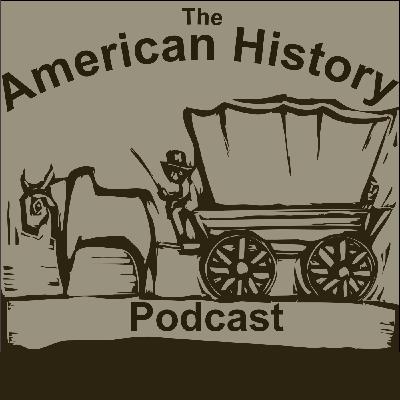Discover Rejects & Revolutionaries (American History Podcast)
Rejects & Revolutionaries (American History Podcast)

106 Episodes
Reverse
This episode is identical to the last episode, but because I'd uploaded a truncated file the last time, and the file change itself can cause some technical glitches, I'm just re-uploading this as a whole new episode. This one will expire at the end of the month.
Information about this year's Intelligent Speech Conference! 35 presentations in four virtual rooms bringing together the independent educational podcast community. This year's theme: Crossings Date: June 25, 2022 Place: Your home, via Zoom Tickets: $20 before June 1. 10% off with promo code RnR. Standard price $30. Learn more: https://intelligentspeechconference.com
An audio-only version of my presentation at the 2022 Intelligent Speech Conference. For video, click here! In this presentation, I took a step back to explore the process of settling a new colony, a big-picture discussion of the colonies we've discussed through the lens of 20th Century research on settlement requirements and dynamics. It should surprise no one that a huge factor in success vs. failure deals with psychology and settler mental health, but it is an angle that's been oft overlooked in those early histories.
Hopefully we'll be spending a fair amount of time together, so here's a quick introduction to me and what you can expect from the podcast.
The early years of Tudor reign saw unprecedented changes in English society. The aftermath of Henry VIII's reforms would ultimately drive people to America, and the social fragmentation he encouraged would lead to American regional differences, even much later. A message from 2022 me: This is the first podcast episode I ever recorded, and it's rough. It's significantly less rough than the 4+ takes I did before this one! But my audio gets continually better, I promise. If this topic interests you, I hope you'll stick around!
Henry VIII had created extraordinary social upheaval, and it was up to his successors to manage the situation as peacefully as possible. Elizabeth I and James I/VII both managed to do that. Still, some people didn't fit into England's new "normal," either being pushed out economically, or holding values that clashed with their solutions.
Roanoke was a key moment in England's colonization of the New World, the first real attempt at establishing a settlement. It's a perfect insight into what made settlements fail - bad communication, bad timing, expense. Of course, it's also known for its mystery, so I've selected what I think are the top three pieces of evidence of what happened to the colonists.
When the first settlers arrived in Virginia, it seemed like paradise. They met the local peoples, explored the lush forests, and selected a settlement location. Unfortunately, they'd spent too long at sea and used their provisions, and some of the settlers clearly weren't who they said they were.
When Newport left, Jamestown fell into chaos. One man was executed, and another's connections to the Gunpowder Plot revealed. John Smith took control, first getting food, then exploring, then meeting Pocahontas as a prisoner of the Powhatan.
Newport arrived just in time to prevent Smith from being hanged, but the two clashed strongly over how to run the colony. Over the course of a year, irreparable damage was done to Jamestown, and though Smith was elected president, and the London Company followed his recommendations, it was too late to prevent disaster.
Caught between hostile Powhatan and divided settlers, John Smith fought to keep Jamestown from falling apart. Then, seven ships came with dozens of settlers, no supplies and ambiguous instructions from London. Smith saw himself as the only person who could keep Virginia together, but he became the first casualty of its impending collapse.
The Sea Venture crashed in Bermuda, and over the course of 10 months its passengers built homemade ships big enough to get them to Jamestown. When they reached Virginia, they found most of the people dead of starvation, and the survivors having resorted to cannibalism to survive. When they saw they only had 13 days of food left, they had a decision to make.
Jamestown couldn't survive forever as an underfunded outpost full of people fighting over control of a wooden fort. When Lord Delaware came, he turned Jamestown into a military camp, with martial law. Thomas Dale expanded on his reforms, and soon Jamestown was struggling again - this time under the weight of tyranny and Powhatan war.
The kidnapping of Pocahontas ended 5 years of Powhatan-English attrition and cemented the defeat of Wahunsenaca. Then, with Dale replaced as governor, Jamestown was able to thrive with the end of martial law and the creation of a new legislative assembly. In the penultimate episode of the Jamestown series, Virginia had finally begun to thrive. It was the first American boomtown.
On March 22, 1622, Powhatan warriors killed 25% of Virginia's population and forced the survivors to flee to one of six remaining settlement sites. They starved, and war resumed. This time, though, the Powhatan were vanquished, and Virginia was made a royal colony. The final episode of the Jamestown series, ends with discussion of everyday life in 17th century Virginia.
In 1606, Bartholomew Gosnold and Gabriel Archer led a big new attempt to set up an English New World Colony. Robert Cecil immediately began to interfere and sabotage the company. The Spanish watched, trying to decide whether or not to attack. Finally, a document by John Smith popularized the idea, and led the way for a massive new expedition, whose flagship was the Sea Venture.
After the death of Cecil and Prince Henry, three factions emerged in the Virginia Company. Smythe's businessmen, Sandys's Rebel MPs and Warwick's War Party vied for control of England's New World colonies. When Sandys won, Virginia became deeply linked to the fight between King and Parliament.
For 200 years, Plymouth was referred to as the Brownist Emigration. Brownism was both a form of severe political agitation, and escape from troubled surroundings. It was both enthusiastic, and bitter. But, when the king wanted to put a halt to separatist thought, a group of Puritan Separatists decided to go to Leiden, and from there, to North America.
Getting to America was no easy task, and by the time they set sail they were already in a precarious situation. They'd gone through or been forced to sell nearly half their food, lost a lot of their money, and were being financed by investors who themselves had virtually nothing. They left, though, and 66 days later reached the shores of New England. Outside their patent, they signed the Mayflower Compact, elected a new governor, started a New England tradition and began to explore Cape Cod.
The Pilgrims look for a settlement location, the first baby is born in New England, and after a long, hard winter, they meet a Native American person who tells them more about the region of Patuxet.







Just started this Podcast and I love it. Very interesting and she has an easy voice to listen to. Good research, keeps you engaged. Thank you